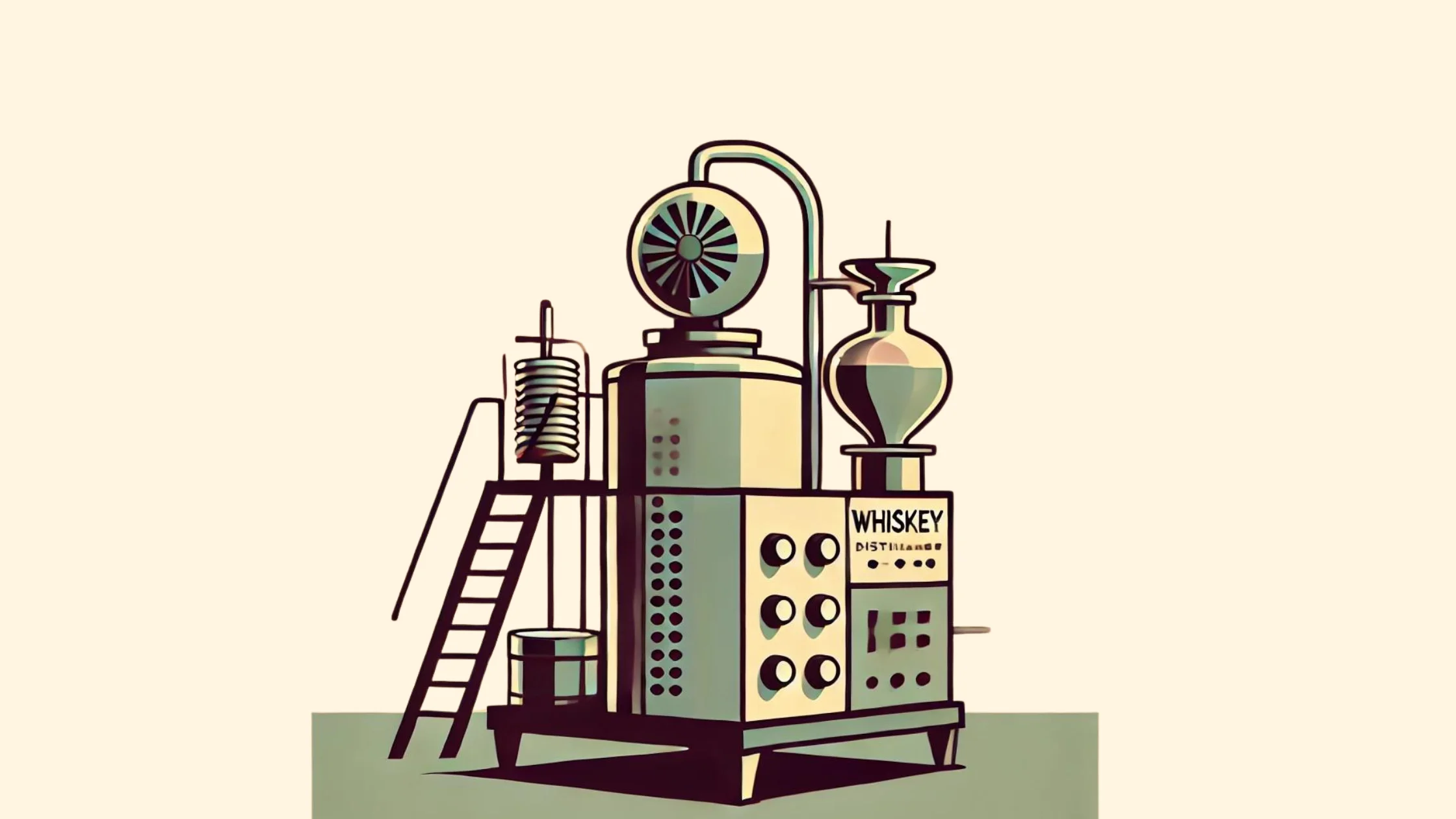Distillation is incredibly important in the whiskey production process. By carefully controlling the mashing, where grains are transformed into a fermentable substrate, and the subsequent fermentation, where yeast works its alchemy converting sugars to alcohol, the foundation of whiskey is laid. The heart of the process lies within the stills—be it the traditional pot stills or the efficient column stills—each playing a crucial role in defining the spirit’s essence. The art of distillation is not simply about purification but about making decisive cuts that capture the ‘hearts’ while discarding the ‘heads’ and ‘tails’. These fractions are critical, as they embody the flavors and aromas that will either enhance or detract from the whiskey’s quality. Following distillation, aging ushers the clear spirit through time, allowing it to mellow and acquire its distinctive hues and tastes from the wooden casks. This maturation is not merely a waiting game but a complex interaction influenced by the wood’s character, the environment’s embrace, and time’s relentless passage. Lastly, legal stipulations ensure that what is bottled and branded as whiskey meets stringent standards, maintaining the spirit’s storied legacy. From grain to glass, each step in the distillation process is a deliberate and essential stride towards crafting the revered elixir that is whiskey.
What is Distillation?
Distillation is a crucial process in whiskey making, serving to refine and concentrate the spirit. At its core, distillation involves the heating of the fermented liquid, or wash, to a point where alcohol vapors separate from water due to their lower boiling point. These vapors are then cooled and condensed back into a liquid state, resulting in a spirit with a higher alcohol concentration.
This method is not solely about increasing potency; it’s an opportunity for distillers to shape the whiskey’s flavor. Through the careful selection of alcohol fractions—known as the heads, hearts, and tails—distillers can influence the final taste profile. The hearts are typically the most desirable cut, carrying the ideal balance of flavors and alcohol purity.
Distillation stands at the intersection of science and craftsmanship. It is a testament to the distiller’s skill and is fundamental to the quality and character of the whiskey, marking a transformative journey from grain to glass.
The historical roots of distillation trace back to ancient civilizations, where the technique was initially used for making perfumes and medicinal concoctions. The practice eventually spread and evolved, with the distillation of spirits becoming a widespread art by the 15th century. Whiskey distillation, in particular, has a storied past, with early records in Scotland and Ireland dating back to the late 1400s and early 1500s.
The science behind distillation is based on the principles of vaporization and condensation. When the wash is heated, components with lower boiling points vaporize first. Alcohol, having a lower boiling point than water, is among the first to vaporize. As the vapors rise through the still, they cool and condense, resulting in a liquid with a higher concentration of alcohol. The shape of the still and the material from which it is made, typically copper, play crucial roles in this process. Copper has excellent thermal conductivity and also helps remove sulfur compounds, improving the taste and smell of the spirit.
Understanding the historical context and the scientific principles of distillation enriches the appreciation of whiskey and highlights the evolution of distillation techniques that contribute to the diverse range of flavors found in whiskeys around the world.
How does distillation work in whiskey production?
Distillation in whiskey production is a critical phase where the alcohol content is concentrated and the spirit begins to develop its unique flavor. The process commences with mashing, where grains are converted into a fermentable liquid, leading to fermentation as yeast metabolizes the sugars into alcohol.
When it comes to distillation, heat is applied to the fermented wash, causing the alcohol to vaporize—separating it from the water due to its lower boiling point. As the vapors rise through the still, the distiller’s expertise is crucial in making precise cuts that isolate the heads, hearts, and tails. The collection of the hearts, the purest cut rich in desirable flavors, is vital for the quality of the whiskey.
Subsequently, the hearts undergo aging, absorbing intricate flavors from the wooden barrels, which contributes significantly to the whiskey’s final character. Each meticulously executed step, from grain to barrel, ensures the whiskey embodies the desired purity and taste.
Mashing: Converting starches to fermentable sugars
Mashing is the critical initial phase where grains are steeped in hot water, activating enzymes that convert starches into fermentable sugars. This sugary solution, known as mash, lays the groundwork for the alcohol production that follows.
Fermentation: Yeast converts sugars to alcohol
In fermentation, yeast is introduced to the mash, where it feeds on the sugars, producing alcohol and carbon dioxide. This step transforms the sweet mash into a mildly alcoholic liquid called wash, setting the stage for distillation.
Distillation: Separating alcohol from the wash
Distillation leverages the differing boiling points of alcohol and water to separate and concentrate the alcohol. The wash is heated, the alcohol vaporizes, rises, and is captured before being condensed back into liquid form. Only the purest fraction, the hearts, is reserved for maturation.
Aging: Maturation in wooden barrels
The clear spirit is then transferred to wooden barrels for aging, where it undergoes a slow chemical transformation. The interaction with the wood imparts complex flavors and a rich color to the whiskey, a process that defines its character and quality over time.
What Types of Stills Are Used in Whiskey Distillation?
Two primary types of stills are central to the art of whiskey distillation: pot stills and column stills. Pot stills, steeped in tradition, are synonymous with batch distillation. Their distinctive shape and the distiller’s skill in making the manual cuts between the heads, hearts, and tails allow for the creation of a spirit that is rich and complex.
Column stills, by contrast, represent the modern approach with their capability for continuous distillation. This efficiency translates into a spirit that is generally lighter and purer, favored for producing whiskey at a larger scale. The choice between a pot still and a column still is a defining factor in the whiskey’s ultimate flavor and aroma, making the type of still a crucial consideration in the distillation process.
Pot Stills: Traditional, Batch Distillation
Pot stills stand as the cornerstone of traditional whiskey distillation, championing the batch distillation method. Crafted primarily from copper, these stills facilitate a unique interaction between the metal and the spirit, encouraging the condensation of heavier, flavor-rich compounds. The batch technique allows distillers to exercise meticulous control over the separation of the heads, hearts, and tails, which is critical in sculpting the whiskey’s intricate flavor nuances.
Column Stills: Continuous Distillation Process
Column stills, representing the evolution of distillation technology, are designed for a continuous distillation process. Their towering structure, equipped with a series of plates or trays, provides a stage for progressive vaporization and condensation. This setup achieves a high level of purity and a lighter spirit, making it the preferred choice for producing whiskey on a grand scale with remarkable consistency.
Why is Distillation Important for Whiskey Quality?
Distillation stands as the defining process in whiskey production, critical for shaping the quality and essence of the spirit. It is during this phase that distillers have the opportunity to purify the alcohol and selectively extract the ideal flavor compounds. The skillful separation of the heads, hearts, and tails—particularly the hearts—is essential for achieving a smooth and refined taste.
The choice of still—whether a traditional pot still for a richer spirit or a column still for a lighter one—also has a profound impact on the whiskey’s final character. Distillation is not just about alcohol concentration; it’s a delicate art that balances science and sensory craftsmanship to create a whiskey that is both complex and enjoyable, laying the foundation for further maturation and depth.
The importance of distillation in determining whiskey quality cannot be overstated. For example, the precise moment when a distiller decides to make the cut between the heads and the hearts can significantly affect the whiskey’s flavor. The heads contain undesirable compounds like acetone and methanol, which can impart off-flavors, while the hearts contain the ethanol and congeners that give whiskey its rich and desirable flavors. A distiller with a keen sense of taste and smell can identify the exact point when the optimal balance of flavors is achieved, ensuring that only the best quality spirit is collected.
Moreover, the distillation process can influence the mouthfeel and texture of the whiskey. A slow and careful distillation allows for the removal of heavier and oilier compounds that can contribute to a whiskey’s body. This is particularly evident in single malt Scotch whiskies, where the pot stills used in distillation contribute to the spirit’s full-bodied character.
The distiller’s decisions during distillation are guided by both tradition and innovation. For instance, in the production of peated Scotch whisky, the distillation process is carefully managed to retain the smoky phenolic compounds imparted by the peat, while still achieving a balanced and palatable spirit. In contrast, the production of Irish whiskey often involves triple distillation, which results in a smoother and lighter spirit, highlighting the subtle flavors and aromas.
In conclusion, distillation is a critical juncture in whiskey production where the distiller’s expertise comes to the forefront, influencing everything from the whiskey’s flavor and body to its overall quality and character. It is a complex interplay of science and art, where each decision has a profound effect on the final product enjoyed by whiskey lovers around the world.
What Factors Influence the Flavor of Whiskey During Distillation?
Several critical factors come into play during distillation that significantly influence the flavor of whiskey. The cut points are essential; they determine which parts of the distillate—the heads, hearts, and tails—are kept or discarded. Capturing the right moment to make these cuts ensures that the desirable flavors are retained while the harsher elements are removed.
Distillation time is another key factor; a slower distillation allows for a greater separation of compounds, which can lead to a more refined and complex flavor profile. Additionally, the shape and material of the still, particularly when made of copper, have a considerable impact. Copper stills are known for their ability to remove sulfides and enhance the spirit’s overall aroma and taste.
Each of these factors, carefully controlled by the distiller’s practiced hand, contributes to the rich tapestry of flavors that whiskey enthusiasts have come to savor and appreciate.
| Region | Cut Points Strategy | Distillation Time | Still Shape and Material | Regional Flavor Influences |
|---|---|---|---|---|
| Scotland | Conservative cuts to prioritize smoothness | Longer, slower distillation for Scotch | Pot stills, mostly copper | Peaty, smoky flavors in Islay Scotches |
| United States | Wider cuts for robust flavor in Bourbons | Varies, often quicker for Bourbon | Column stills for Bourbon, pot for Rye | Sweet, vanilla, and caramel notes |
| Ireland | Triple distillation for purity and smoothness | Extended distillation in pot stills | Pot stills, copper for smoothness | Light, fruity, and floral flavors |
| Canada | Precise cuts for clean flavor in Rye | Slow distillation for Canadian whiskies | Column stills for continuous production | Smooth, light, often with rye spiciness |
| Japan | Delicate cuts for harmony and balance | Careful, slow distillation | Pot stills, often unique shapes | Subtle, diverse flavors, often delicate |
By examining the table, readers can see how regional distillation practices influence the flavor of whiskey. For example, the conservative cuts and longer distillation times in Scotland, especially for Scotch, contribute to the smoothness and development of peaty or smoky flavors, particularly in whiskies from the Islay region. In contrast, the wider cuts used in Bourbon production in the United States allow for a robust flavor profile with sweet, vanilla, and caramel notes.
This detailed table provides a comprehensive view of how distillation factors vary across regions and how they contribute to the distinct flavors of each region’s whiskey, adding depth and context to the original content.
How Does the Aging Process Follow Distillation?
Post-distillation, the aging process commences, a critical phase where the whiskey develops its signature flavors and hues. Stored in wooden barrels, the spirit undergoes a metamorphosis, as it slowly imbibes the wood’s character. The type of wood used, often oak, and the degree of char inside the barrel, significantly influence the whiskey’s flavor, imparting notes such as vanilla, caramel, or spice.
The environment in which the barrels are kept, including variations in temperature and humidity, also plays a pivotal role, affecting the rate of maturation and the complexity of the resulting flavors. The duration of this aging period can vary widely, with longer aging typically contributing to a deeper, more nuanced profile. This stage is essential, as it allows the raw spirit to soften and gain the refined qualities that make whiskey a celebrated and storied spirit.
During this aging process, a series of chemical reactions occur, including oxidation, esterification, and the extraction of compounds from the wood, which contribute to the whiskey’s final taste and aroma. Different aging environments, such as coastal or inland warehouses, can influence these reactions due to differences in climate, air quality, and atmospheric pressure.
To provide a more detailed understanding, the following markdown table exhaustively compares the chemical reactions and environmental factors that influence the aging process:
| Chemical Reaction | Description | Influence on Whiskey |
|-------------------|-------------|----------------------|
| Oxidation | The interaction of oxygen with the compounds in whiskey, leading to the development of new flavors and the mellowing of harsh ones. | Adds complexity and can soften the spirit's harshness. |
| Esterification | The formation of esters through the reaction of acids and alcohols in the presence of catalytic enzymes. | Contributes to fruity and floral notes in the whiskey. |
| Extraction | The leaching of compounds like lignin, tannins, and vanillin from the wood into the whiskey. | Imparts flavors such as vanilla, caramel, and wood spice. |
| Evaporation | The loss of liquid through the barrel, known as the "angel's share," which concentrates the whiskey. | Intensifies the flavors and increases the spirit's smoothness. |
| Environmental Factor | Coastal Aging | Inland Aging |
|----------------------|---------------|--------------|
| Climate | Typically more humid and cooler, with sea air influence. | Can vary widely but often drier and subject to more temperature extremes. |
| Air Quality | Salty, maritime air can impart a subtle briny character to the whiskey. | Cleaner air may result in a purer expression of the wood's influence. |
| Atmospheric Pressure | Higher humidity and stable pressure can slow the aging process, allowing for a more gradual flavor development. | Fluctuating pressure and lower humidity can accelerate aging and lead to a different rate of chemical reactions. |
This enhanced section, along with the detailed markdown table, provides readers with a comprehensive view of the aging process, explaining the science behind the transformation that occurs post-distillation and how the environment plays a crucial role in shaping the whiskey’s final character.
What Are the Legal Requirements for Whiskey Distillation?
Whiskey distillation is governed by a framework of legal requirements that safeguard the spirit’s integrity and define its identity. Geographic indicators play a crucial role, stipulating that certain whiskeys must originate from designated regions—like Scotch from Scotland or Bourbon from the U.S.—to bear their respective names.
Minimum aging periods are also legally enforced, requiring whiskey to mature in barrels for a specified duration before it can be marketed under that classification. This aging process is essential in developing the whiskey’s character and is non-negotiable in the eyes of the law.
Moreover, alcohol content regulations determine the proof at which whiskey can be distilled and subsequently bottled. These limits ensure consistency and quality, and compliance is mandatory for producers. Together, these regulations form the backbone of legal standards that uphold the storied traditions and high standards of whiskey production worldwide.
Geographic Indicators: Region-Specific Regulations
Geographic indicators are legal criteria ensuring that whiskey originates from a specific region to bear its name. These indicators protect the distinct identity of whiskeys like Scotch or Bourbon, linking their heritage and quality to their place of origin. Compliance with these regulations is essential for maintaining the authenticity and reputation of regional whiskey styles.
Minimum Aging Periods: Required Time in Barrels
The minimum aging periods set by law are non-negotiable timeframes that whiskey must spend in barrels to develop its desired flavor profile. This aging is crucial for the transformation of the spirit, allowing it to acquire the complexity and smoothness associated with fine whiskey. Each whiskey type has a legally defined maturation period that producers must adhere to.
Alcohol Content Regulations: Proof Limits Before Bottling
Alcohol content regulations specify the minimum and maximum proof at which whiskey can be distilled and bottled. These legal limits are in place to ensure the safety and consistency of the whiskey, providing a benchmark for quality across the industry. Distillers must carefully monitor and adjust the alcohol content to meet these standards before the whiskey can be sealed and sold.





